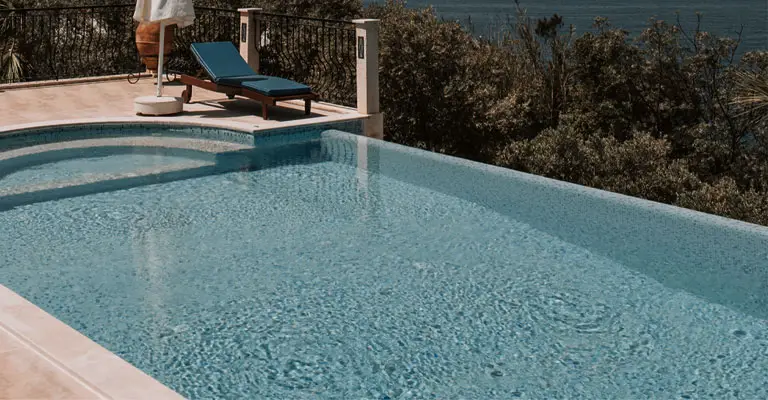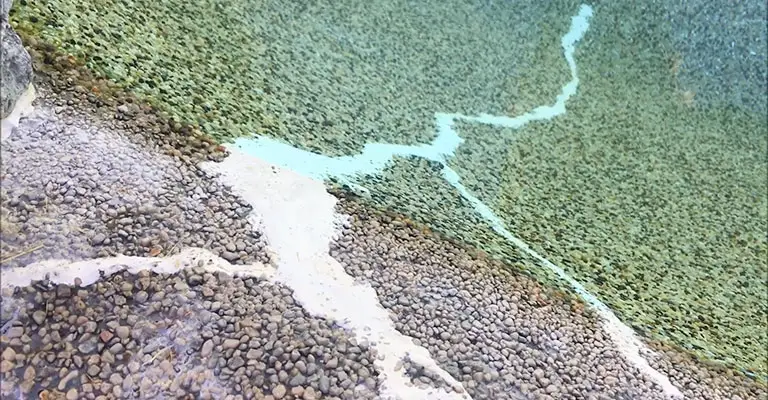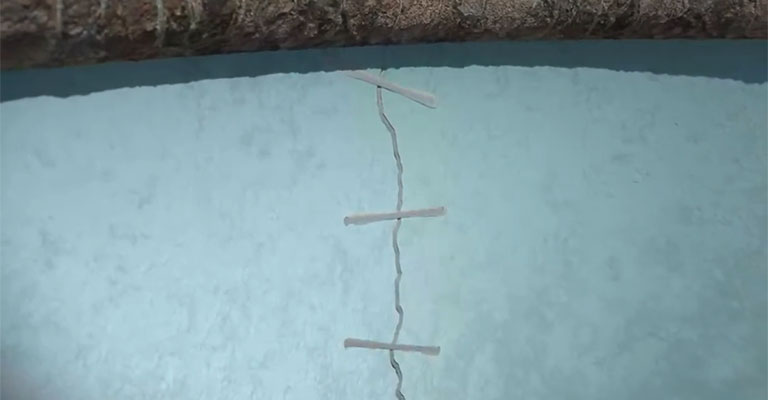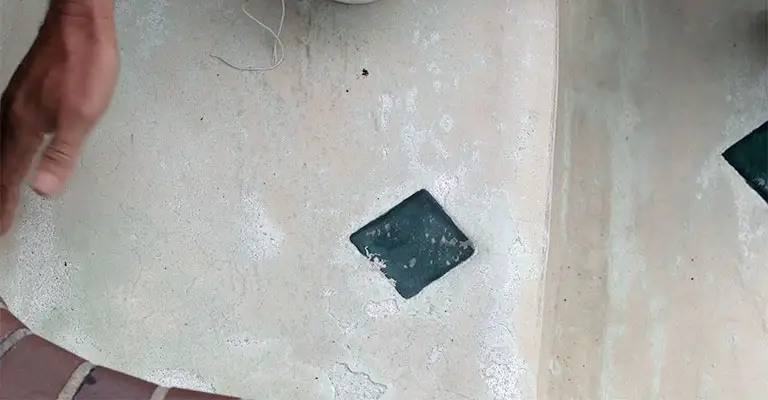Pool professionals have been recommending Diamond Brite for the last few years, and its popularity has skyrocketed. With its resistance to just about any pool chemicals, this finish is perfect for a majority of pools.
The unique granular surface on the pool’s finish prevents algae and other organisms from sticking and makes it easy to clean.
There are obvious plusses to this finish, but it also has a few downsides. In this article, I’ll focus on the Diamond Brite pool finish problems so you can anticipate what to expect from them.
Read this article on how the finish can go wrong so that you’re prepared for what to expect. Most problems with the finish arise from the plaster, and they can typically be fixed by touch-ups or re-applying the finish.
Is Diamond Brite a Good Pool Finish?

Diamond Brite pool finishes are simple to use and last for a long time, unlike many other pool finishes. In addition to that, it is also easy on the wallet and good for swimmers who have sensitive skin.
This is a great upgrade to bring your existing pool (new or renovated) up to the most desirable finish possible. Quartz blend with Portland cement is used in both types of projects – new pools and pools needing renovations.
There is no smoothness to Diamond Brite since it is an exposed aggregate. However, in addition to having a life expectancy of 10 to 15 years, it has a stunning appearance that makes it a great choice for some pools.
The finish of the product makes maintenance extremely easy. Microbes and algal growth have trouble adhering to this finish, and if they do, they can be easily scraped off.
Most Common Diamond Brite Pool Finish Problems
As with other plaster materials, this material does have some disadvantages. By examining the issues that this finish presents, you will better understand what to expect.
Despite being chemical-resistant and lasting over a decade, Diamond Brite pool finishes are not without their downsides. Listed below are a few. However, it’s crucial to note that many of these problems are caused by deteriorating plaster.
1. Bond Failure

In some instances, your Diamond Brite pool finish may not stick to the plaster properly, resulting in the plaster falling off.
In addition, the plaster often does not hold on to the finish to which it is supposed to attach to, causing bond failure.
When a pool has been renovated or replastered, this can be considered a common phenomenon.
There are numerous situations in which replastering causes bonds to fail, especially when the new plaster is unable to adhere properly, or the finish does not offer adequate grip.
Plastering pool tiles need to be done by very careful professionals. There is a possibility that the whole procedure will need to be repeated if it goes wrong.
Solution:
What is the best way to fix a bond failure in a swimming pool? There is a simple yet time-consuming solution to repairing Diamond Brite pool finishes that have failed.
The problem can easily be solved by removing all plaster and patching the area. However, you should proceed cautiously as there could be structural issues.
Initially, it is essential to remove the plaster entirely then patch the spots where the bond failure occurred. Those spots would need to be patched so the cement wall wouldn’t break and cause a bond failure.
2. Cracking

Crazing or checking referred to as cracks in the finish, can also occur. However, cracks of this type are typically small, hard to detect, and not as common.
In extreme weather conditions, for instance, they may occur as a result of a fast-curing finish.
If the weather conditions are extremely dry, windy, or both, you might find that Diamond Brite pool finishes cracks on the pool tiles.
It is usually caused by improperly applied plaster or by not allowing the finishes to dry before using them completely.
Solution:
You don’t need to worry about the pool’s structure and finish being threatened by these cracks as they might grow with time. Because most of these cracks are surface-based, they can be easily patched or acid-washed by a professional.
Patches can be used to repair minor cracks in a vinyl liner pool. Alternatively, you can have the pool acid washed.
3. Etching

Because of acidic reactions between the coating and the water in the pool, itching causes the coating to turn beige. Some people think the problem stems from unwanted algae, but it is actually a result of the water’s pH level.
A pH imbalance is responsible for etching, just as it is with scales, but this time the pH balance is lower; this means that the water gets acidic.
Despite being somewhat similar to scale, this often occurs due to the pool water’s condition.
As an example, acidic water can easily cause rough surfaces or pockmarks in the finish or plater. Furthermore, there is a possibility that the plaster will discolor and turn beige.
Solution:
Eventually, the Diamond Brite finish becomes damaged between the water and the etching, causing a hole inside. As a result, owners of Diamond Brite pools are frequently baffled, as they do not know how to repair the damage due to etching.
When the wall finishes are breaking down, replastering is usually required, as it is beyond repair with only chemicals. Likewise, etching typically requires complete renovation of the swimming pool.
4. Scale

Scale is one of the problems you should expect to face when using this coating. A major cause of this problem is hard water that is treated with lots of chemicals to make it soft.
On your finish, you might sometimes see patches of scales. Scales like these appear on finishes due to hard water.
Water and minerals have a slight chemical reaction that bonds the calcium and magnesium particles to the plaster. This causes scale patches to appear.
In the presence of minerals present in the water, even a small reaction between the water and those minerals results in hard water. The water inside the pool becomes acidic due to the chemical reaction.
Solution:
Diamond Brite pool coatings and finishes suffer from a problem of scale, which is a major drawback.
Therefore, the pool might need to be replastered if the damage is severe. Using soft water in the pool or replastering can help remove scale, but it’s not quite so simple.
The process of removing hard water and turning it into soft water usually requires a lot of chemicals. Check the water’s PH level before treating it and adjust the treatment accordingly.
If you want to make a home remedy for removing pool titles, you can use vinegar and water solution and scrub it over them with a brush. However, it may be necessary to change the entire coating to prevent the hardness from increasing.
Why Should I Repair Diamond Brite Damage?
For your diamond Brite finish to last as long as possible, you must maintain it properly.
Keeping it in good condition also maintains its structural integrity. For example, the following problem might occur if you don’t resolve Diamond Brite finish problems.
The Aesthetics Get Boring
In addition to the tired-looking surface, the staining that occurs if Diamond Brite surfaces are not repaired can become a problem.
Furthermore, it is crucial to understand that repairing damage is crucial to ensuring the safety of users, as leaving damage unattended could result in the flooring losing its slip resistance.
Delamination And Bubbles Are Only Going To Get Worse
Delamination and bubbles in pools only get bigger with time. Diamond Brite damages are serious as they can lead to your swimming pool delamination getting worse and expanding–especially if you use it a lot.
A large spot will cost you an entire diamond Brite resurface instead of a quick patch, which could have virtually eliminated your need to replace your Diamond Brite in the future. What a bother!
The long-term benefits of repairing diamond Brite damage are significant.
Leaks Can Develop From Cracks
Cracks may expand into the pool structure if you do not repair your diamond-bright finish.
The presence of cracks in Diamond Brite may not necessarily result in a leak. However, when the cracks become widespread or penetrate the structure of your swimming pool, a leak will result.
A hairline crack in a structure can cause water loss of several inches per day. These cracks can expand over time, increasing water bills and repair costs.
Final Words
You will encounter these problems most often with Diamond Brite pool finishes. However, many of these Diamond Brite pool finish problems can be solved easily, and the final product will last for decades if taken care of.








